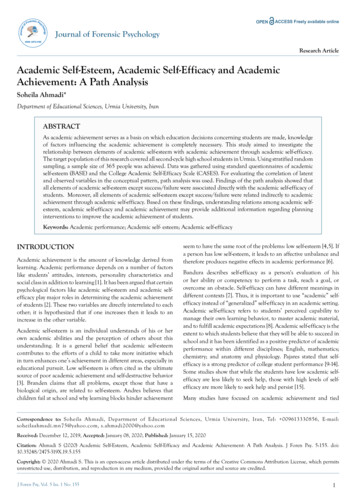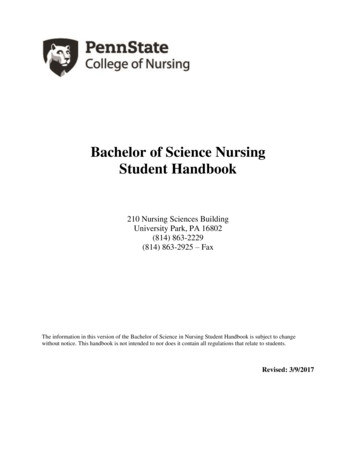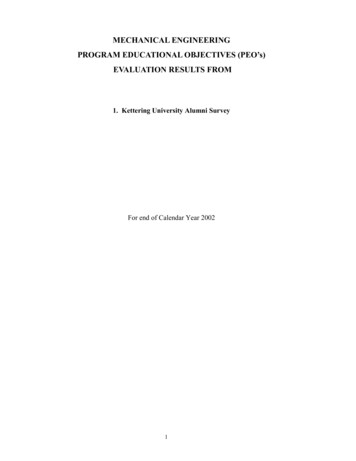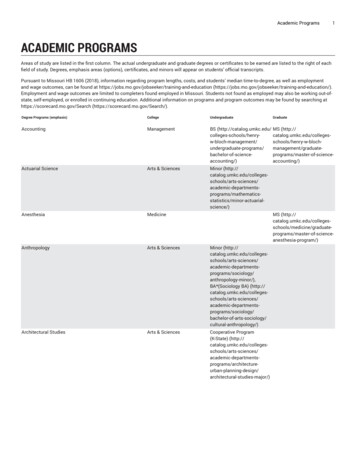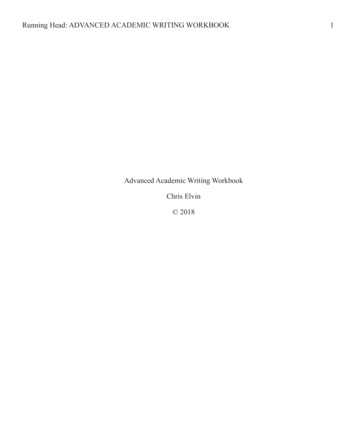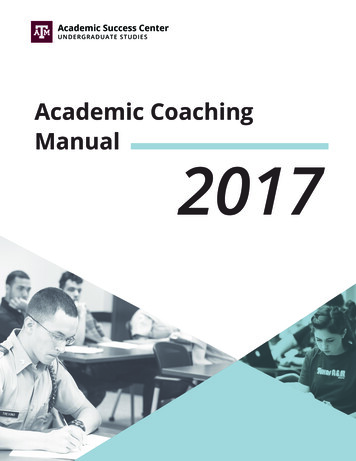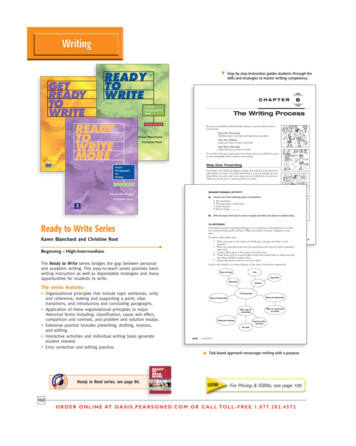
Transcription
AssessmentGuide forAcademic ProgramsCollege of Business Administration(4th Edition, July 29, 2016)1
Table of ContentsASSESSMENT GUIDE FOR ACADEMIC PROGRAMS . 3SECTION 1: WHAT IS ASSESSMENT? . 4SECTION 2: CREATING A MISSION STATEMENT . 11SECTION 3: CREATING LEARNING OUTCOMES . 17SECTION 4: ASSESSMENT METHODS . 28SECTION 5: PLANNING FOR DISSEMINATION AND USE. 40SECTION 6: YOUR CONTINUOUS IMPROVEMENT PLAN . 42SECTION 7: ANALYZING ASSESSMENT RESULTS . 56SECTION 8: YOUR ASSESSMENT REPORT. 63SECTION 9: CLOSING THE LOOP . 65SECTION 10: Data/Evidence/Artifact Repository . 69ANNOTATED BIBLIOGRAPHY . 72References . 74Appendix A: Data Flow . 76Appendix B: Reporting Flow. 772
ASSESSMENT GUIDE FOR ACADEMIC PROGRAMSA Programmatic Guide to Creating an Assessment Plan and Reporting Assessment ResultsThe purpose of this workbook is to provide a guide for developing an assessment plan foran academic program and for summarizing assessment results in an assessment report.The information that is developed as a result of the use of this guide will be uploaded to theTAMUCT academic assessment – continuous improvement repository, TaskStream, foundat https://www1.taskstream.com/. For the purpose of academic assessment for theSouthern Association of Colleges and Schools – Commission on Colleges, an academicprogram is defined as any undergraduate or graduate degree program 1. If the degreeprogram has multiple majors, then each major is further defined as an assessable academicprogram. This guide has been divided into nine sections, providing guidance for developingassessment plans from initial development through the submission of annual reports, and isoutlined below. Section 1 of the workbook will provide an overview of assessment and theassessment cycle. Sections 2-5 cover each step in the process of developing anassessment – continuous improvement plan. Section 2 will provide a guide for the process of creating a program missionstatement, and the foundation of an assessment plan. Section 3 will provide a guide for the process of developing measurable studentlearning outcomes. Section 4 will assist in designing assessment methods and measures. Section 5 will help provide guidance for the dissemination of the assessmentresults and how to use them to improve the program. Once Sections 2-5 have been completed the assessment plan can be completedusing the procedure provided in Section 6. After the assessment has been completed and assessment data has beenobtained, Section 7 will provide guidance for analyzing the data and the preparationof a summary, including the proposed changes to the program based on the results. Once the data has been analyzed, procedures provided in section 8 will aid thecompletion / submission of the annual assessment report. Section 9 explains what happens with the report once it has been submitted. Section 10 provides information on data repository and report flows1The Association to Advance Collegiate Schools of Business (AACSB) requires assessment on the overall program,not to the major level, i.e. BBA, BAAS, BS CIS, MS Accountancy, MS IS MBA, MS HRM, MS MGT & LDRSHP3
SECTION 1: WHAT IS ASSESSMENT?The purpose of this section is to provide you with 1) an overview of assessment at theCollege of Business Administration, Texas A&M University - Central Texas; 2)definitions and an explanation of what assessment is not; 3) questions assessment mayanswer about your program and 4) a description of the assessment process. At the endof this section you will be prepared to start developing your assessment plan.Assessment at the College of Business Administration, Texas A&M University Central TexasIn this era of accountability, assessment has come to dominate the discourse abouthigher education and its progress. The political pressures to assess student learningand to hold campuses accountable have increased into the new millennium. Universitiesare now facing external pressures as accrediting bodies are requiring them to assesshow well their academic programs are meeting goals to inform improvement efforts. Theability of universities in the South to offer student financial aid from federal sourcesdepends on their ability to remain accredited by the Southern Association of Collegesand Schools Commission on Colleges (SACSCOC). The accreditation process is partlybased on the institution’s ability to demonstrate that it has an ongoing assessmentprocess that continually examines the quality of services and programs and uses thisinformation to make improvements. Dissemination and use is essential. Creating anassessment plan and collecting data are not enough. According to SACSCOC, theuniversity (and COBA) must comply with the following assessment requirements(SACSCOC, 2012b):2.5: The institution engages in ongoing, integrated, and institution-wide research-basedplanning and evaluation processes that (1) incorporate a systematic review ofinstitutional mission, goals, and outcomes; (2) result in continuing improvement ininstitutional quality; and (3) demonstrate the institution is effectively accomplishing itsmission.3.3.1: The institution identifies expected outcomes, assesses the extent to which itachieves these outcomes, and provides evidence of improvement based on analysis ofthe results in each of the following areas: (Institutional ducational programs, to include student learning outcomesadministrative support servicesacademic and student support servicesresearch within its mission, if appropriatecommunity/public service within its mission, if appropriate3.4.1: The institution demonstrates that each educational program for which academiccredit is awarded is approved by the faculty and the administration.(Academic programapproval)4
The College of Business Administration (COBA) is committed to creating a culture ofevidence, one that is based on using data to inform decision makers and to improve thequality of education on campus. In accordance with SACSCOC regulations, COBA hasestablished a goal that all academic programs will develop mission statements, learningoutcomes and plans to carry out assessment, including the use of results. Assessmentmust be conducted annually for any major or field in which COBA offers a degree.Generally, minors and concentrations do not require assessment plans for SACSCOCpurposes. However, in those programs for which the institution does not identify amajor, assessment is required for the “curricular area or concentration”, for example BSCIS, Management/Networking and Software Engineering & Database Design(SACSCOC, 2012a, p. 64). The TAMUCT assessment cycle is from January throughDecember each year. Therefore, in December, COBA academic programs must submitan annual assessment plan for that calendar year and a report summarizing theassessment results from the previous academic year to the Office of InstitutionalEffectiveness, through the vice presidents for undergraduate and graduate studies. TheOffice of Institutional Effectiveness & Academic Enhancement (IEAE) will review theassessment plans for the coming year and contact programs if revisions are required.The assessment reports summarizing assessment results will be reviewed by the COBAdepartment chairs and will provide summaries and recommendations to the Dean,COBA, and as required, feedback to the individual programs using TaskStream as themedium for the reports. The vice presidents for undergraduate studies and for graduatestudies will review the reports from each college and present their recommendations tothe provost. The Provost and Deans will work with the department chairs and programleads as needed to improve student learning based on these assessment results. Amore detailed timeline of our assessment cycle is included below.COBA Annual Assessment Cycle – in TaskStreamAcademic programs review their assessment results from theprevious calendar year and upload their findings in TaskStream.Close of Fall TermAcademic programs also review and revise continuousNo Later Thanimprovement plan as needed for the forthcoming year. A planDecember 15must be resubmitted, in TaskStream, every year forrecordkeeping purposes even if no changes are made.Deadline for academic programs to submit ContinuousClose of Fall TermImprovement Cycle (improvement plan, findings, action plan, andNo Later Thanstatus report) from the previous academic year, using theDecember 15Submission & Read Reviews function in TaskStream.Beginning of Spring The continuous improvement plan for the coming calendar year isTermfinalized in TaskStream and submitted for review.No Later ThanJanuary 31Dean, COBA and the Department Chairs review, and approveSpring Termwhere applicable, annual continuous improvement reports fromNo Later Thanthe previous calendar year, in TaskStream. The Dean and ChairsMarch 30follow up with academic program leads as needed.5
End of Spring Term Updates to the reports are conducted, as requiredNo Later ThanMay 31Fall, Spring,Academic programs conduct assessment and collect dataSummer Semesters according to their plan for that year.What Assessment Is and What Assessment Is NotAssessment is the systematic and ongoing process of gathering, analyzing and usinginformation from multiple sources to draw inferences about characteristics of students,the curriculum, programs, and units for the purpose of making informed decisions toimprove the learning process. (Linn & Miller, 2005)In order to understand what assessment is, it may be helpful to understand whatassessment is not. The terms assessment, test, grades, evaluation, and research areoften confused because they all involve the process of collecting information aboutstudent learning. However, they are distinct in their purposes, methodologies, and basicphilosophies of modes of inquiry. The following definitions should provide you with abetter understanding of what assessment is.Assessment may be defined as “the systematic and ongoing process of gathering,analyzing, and using information from multiple sources to draw inferences aboutcharacteristics of students, the curriculum, program, and units for the purposes ofmaking informed decisions to improve the learning process” (Linn & Miller, 2005). In thisrespect assessment also includes the formulation of value judgments in terms of usingthe information gathered to determine the success of the program and to makeimprovements in student learning.A test is a type of assessment that consists of a measure of a sample of behavior. Itdiffers from assessment in that assessment includes a broader array of performancetasks rather than just a single measure that a test represents. Assessment results givebroader descriptions of what students are learning since they include more than onemeasure. (Linn & Miller, 2005).A grade is a nominal value that provides an overall summary of a student’sperformance. Grades are concise and easy to compute, however they haveshortcomings when being used for the purposes of making informed improvementssince they may not be specifically linked to learning goals and standards making itdifficult to identify the student’s strengths and weaknesses. For example, a grade of Con an English paper may reflect adequate content, poor mechanics, average synthesis,and good effort or may reflect poor content, adequate mechanics, and averagesynthesis (Linn & Miller, 2005; Suskie, 2004).Evaluation is defined as “the systematic process of gathering, analyzing, and usinginformation from multiple sources to judge the merit or worth of a program, project orother entity” (Rossi, Lipsey, & Freedman, 2004). Just like assessment, the utility of data6
is in decision making. Evaluation also includes value judgments concerning thedesirability of results and is not limited to quantitative descriptions. However, evaluationdiffers from assessment in terms of the unit of analysis. Evaluation is concerned with allmajor goals of a program and not just with student learning. Therefore, evaluation is abroader term than assessment (Rossi et al, 2004; Suskie, 2004).Research may be defined as the systematic process of gathering, analyzing, and usinginformation from multiple sources to draw inferences, and test hypotheses, in order todiscover, establish fact, or revise accepted theories or laws. The largest criticism thatfaculty often make about assessment is that it is “not research” and will not producegeneralizable results. This is correct in that assessment is not post-positivistic, thetraditional framework guiding most faculty research. Assessment is a type of actionresearch. Its primary goal is to improve practice not to generate theoretical knowledge(Kemmis & McTaggart, 2005). Experimental control and random assignment are not asimportant and in many cases are just not possible. Assessment also differs fromempirical research in that collaborative reflection is imperative in making modificationsbased on shared feedback.What Questions Assessment Can AnswerIn order to gain a better perspective of what assessment is, it may be helpful tounderstand what questions assessment can help to answer about your program.Formulating an assessment question and determining how results will be used are theessential first steps in developing a plan. These steps will dictate the formulation oflearning outcomes as well as the selection of assessment methodology. For example, ifyou are interested in determining whether or not your students are achieving a certainlevel of competence (a standards-based question) then most likely you will design yourassessment procedure around collecting data and comparing your findings against astandard that is set a priori (set before you collect the data). Interpretations will becriterion referenced (i.e., performance will be compared to a preset numerical standard).However, if instead you are interested in how your students compare to your peers (abenchmarking question), then you will probably identify standardized instruments thatallow for norm-referenced interpretations. If you are interested in whether or not yourstudents are improving (a value-added question), then your assessment procedures willmost likely include some type of pre/post design (collecting data from the same studentsat two successive time points to measure change over time). Finally, if you areinterested in whether or not your program or successive groups of students areimproving (a longitudinal question), then a cross-sectional design should be used—onein which the same assessment is given to successive groups of students.The Assessment ProcessAssessment is an ongoing, iterative process that uses results to inform decisions andmake improvements. In order to improve, careful planning is necessary. Learning goalsand outcomes must be clearly specified, appropriate measures must be selected, datacollection must be carefully executed and most importantly results must be shared for7
improvements to occur. The figure below illustrates a cycle of interlinked activities thatfacilitate continuous improvement. (Figure adapted from Maki, 2004)Seven Steps to Closing the LoopStep 1: Creating an Infrastructure for Assessment: Organizing an AssessmentCommitteeBefore beginning, it is important to set up the appropriate infrastructure for assessmentin order to ensure that the process is self-sustaining. The college or department maywant to organize a faculty retreat to devote specific time to devising a plan. Asuggestion is that departments establish an assessment committee, with a rotating chairwho will lead the process and ensure the annual reports are completed by eachprogram lead. This will alleviate faculty workload as well as provide quality assurancefor planning and dissemination. It is essential that all faculty in the program participate inthe decision making process and in reviewing the results. The assessment process ismore likely to be self-sustaining if faculty collectively agree on what is important, buyinto assessment procedures, and decide as a group what the data mean and how to8
improve. As Allen (2004) notes, “Assessment is not something someone does to you orfor you; it is the responsibility of the faculty who control and offer the program.” Pleasenote faculty members are well suited to discuss the assessment results within themajors in their departments. This will be sufficient for SACSCOC accreditation;however, for AACSB accreditation, entire programs will have to meet to discuss results,implications, and needed actions to improve the programs. Programs within COBA (i.e.BBA, MBA) cross over departments and representation is required from thesedepartments.Step 2: Defining the Mission of the Program (Degree Program or Major)Each program must formulate a mission statement that will constitute a broad statementof its goals, values, and aspirations.Step 3: Defining the Program Learning OutcomesEach program must formulate program level learning outcomes that describe thespecific abilities, knowledge, values, and attitudes it wants students to acquire as aresult of the program. Three to five outcomes per program is ideal.Step 4: Selecting assessment methods and identifying targetsPrograms may use several different methods to measure student learning outcomesand must include direct measures of learning for each learning outcome. This is aSACSCOC requirement. They must also identify expected levels of performance foreach outcome.Step 5: Collecting the DataIt is important to determine how the data collection will be implemented (i.e., who willcollect the data, where it will be collected, and who will be sampled). All data will bereported in the form of group data to ensure the privacy of those who are assessed.Step 6: Analyzing the ResultsIt is important to summarize and report the data in a meaningful way to communicatefindings to program faculty. An overall or annual report can then be generated throughTaskStream.Step 7: Closing the LoopNo matter how results turn out, they are worthless unless they are used. The results ofassessment data should be disseminated to faculty in the program as well as facultyoutside of the program to obtain their ideas about how to improve the program.SACSCOC and AACSB is particularly interested in seeing documentation for this step.In some cases changes will be minor and easy to implement, while others will be moredifficult and will have to be implemented over multiple years.Developing an Assessment Plan – Continuous Improvement PlanPrior to conducting assessment, academic programs should develop an annualcontinuous improvement plan that details what the program intends to do and why. It is9
critical to have a plan that clearly defines the program’s educational mission andoutcomes that faculty expect students to demonstrate as a result of the program. Theplan should also include a detailed description of how the outcomes are going to beassessed and how the results will be used. The table below describes the componentsof a continuous improvement plan and shows an example from TaskStream. Sections2-5 that follow in this workbook will provide a more detailed description of theseprocesses.Components of a Continuous Improvement PlanMission StatementOverall description of the program’s purpose, its primaryfunctions, and its educational goals for its studentsLearning Outcomes3-5 statements of the knowledge, skills, and abilitiesstudents will possess and can demonstrate uponcompletion of the programAssessment Methodsand MeasuresThis section will include the measure’s name, descriptionof assessment, and criteria for success.Plans for Use andDissemination ofAssessment ResultsThis section will include the implementation plan andtimeline, as well as the key and responsible personnel fordata collection and reporting on the measure.Example Continuous Improvement Plan in TaskStream10
SECTION 2: CREATING A MISSION STATEMENTNow that you have a basic understanding of assessment, you are ready to begin bydefining your program’s educational mission. This section provides a simple tutorial onwriting a mission statement. The worksheet provided in this section can be completedas a group exercise with program faculty to create your program mission statement.When that is done, you can use the template provided in this section to complete yourmission statement. (An electronic version of the template is available on the COBAAcademic Assessment website). Once completed, use the checklist also provided inthis section to review the mission statement to ensure that it is sufficient. A samplecompleted mission statement is included at the end of the section.Creating a Program Mission StatementUnderstanding and articulating what your program is trying to accomplish is necessaryfor a successful assessment plan. It is important to carefully specify and obtain aconsensus from faculty members in your program on the program’s vision, values andgoals that will serve as guiding principles for developing outcomes and collecting data.Thus the time you and your faculty spend developing your mission statement isimportant. An important note is to ensure the mission of each program is linked to boththe university and college missions.Definition of a Mission Statement:A mission statement is a broad statement of what the program is, what it does, and forwhom it does it. It is the initial point of reference for any program. (Adapted fromUniversity of Central Florida UCF Academic Program Assessment Handbook February2005 Information, Analysis, and Assessment)SACSCOC requires that every academic program on campus have a missionstatement. For any given program a mission statement should 1) provide a cleardescription of the purpose of the program and its primary functions; 2) identify who theprogram will serve and ; 3) contain a description of how the program will contribute tothe development and careers of the students participating. Please note that a visionstatement is not required but is recommended.The mission statement should be clear, powerful and broad enough to guide yourdecision-making and provide the foundation for your learning outcomes. In addition, themission statement should be able to stand on its own and distinguish itself from otherprograms if the program’s name were removed. Most importantly the mission statementshould be aligned with the mission statement of the University and College.Complete the given worksheet to help develop your mission statement. Ideally, thisshould be done as a group exercise with program faculty so that there is consensus andbuy-in. Once the exercise has been completed, you can take the answers from the11
exercise to complete the template. After completing the template, have program facultyreview it using the checklist. When you are able to check “yes” on each item in thechecklist, your mission statement is complete.Worksheet to Create a Mission StatementBy completing the questions below, you will be able to create a program missionstatement. It may be helpful to do this as a group exercise with program faculty or yourprogram assessment committee.1. What is your academic program’s primary educational purpose? For example,does your program provide certain types of skills (critical thinking, analytical thinking,writing or communication skills, etc.) or broad background/theoretical foundation in acertain academic discipline(s) (e.g., art history, biology, philosophy, sociology, etc.)?2. What is your program providing to your students to meet this purpose? Forexample, what activities does your program use to facilitate this learning? Coursework,labs, research projects, etc.?3. Who are your program’s key stakeholders? In other words, who does yourprogram serve? Undergraduate students? Graduate students? Non-traditionalstudents? Students preparing for graduate school?4. What type of careers or further study will the program prepare students for?12
Mission Statement TemplateUsing the information you entered on the previous worksheet, complete thetemplate below to form your mission statement. (NOTE: This template is just tofacilitate your writing a mission statement. You are not required to use this wording butyou should include all of its components in your statement.)The mission of [insert the name of your program here] is to[insert your response from question 1 on the worksheet]by providing majors[insert your response from question 2 on the worksheet]in order to[insert your response from question 3 on the worksheet][OPTIONAL: Insert additional clarifying statements including a description of how theprogram will contribute to students’ educational and professional opportunities]13
Mission Statement ChecklistNow that you have created your mission statement, use this checklist to help determineif your statement is effective and clearly defines the goals and vision of the program.Please fill out the questions listed below.YESNOIs the mission statement brief and memorable?Is the mission statement distinctive? (Can it stand on its own anddistinguish itself from other programs if the program’s name wereremoved?)Does it clearly state the purpose of the program?Does it indicate the primary functions or activities that the programoffers?Does it identify the major stakeholders?Does it support the University’s and school’s mission?If you checked “NO” on any of the items above, go back and revise your missionstatement accordingly.When you are able to check “YES” on all of the items above, your mission statement iscomplete and you are ready to go to the next section where you will develop yourlearning outcomes.14
Sample Worksheet to Create a Mission StatementBy completing the questions below, you will be able to create a program missionstatement. It may be helpful to do this as a group exercise with program faculty or yourprogram assessment committee.1. What is your academic program’s primary educational purpose? For example,does your program provide certain types of skills (critical thinking, analytical thinking,writing or communication skills, etc.) or broad background/theoretical foundation in acertain academic discipline(s) (e.g., art history, biology, philosophy, sociology, etc.)?Develop business managers and leaders by providing a high quality and relevant education inbusiness management including small business and entrepreneurship2. What is your program providing to your students to meet this purpose? Forexample, what activities does your program use to facilitate this learning? Coursework,labs, research projects, etc.?The program provides the majors the ability to professionally communicate, reason ethically,become globally business aware, and integrate business knowledge with their technical,military, or supervisory experience3. Who are your program’s key stakeholders? In other words, who does yourprogram serve? Undergraduate students? Graduate students? Non-traditionalstudents? Students preparing for graduate school?This program serves undergraduate students with previous technical training, military trainingand/or supervisory experience4. What type of careers or further study will the program prepare students for?This program will prepare graduates to lead and manage an organization within the chosentechnical field, move on to leadership and management positions within other industries, andto further their education in a selected graduate level business or management program.15
Sample Completed Mission Statement TemplateThe mission of [Bachelor of Applied Arts and Sciences – Business Management ] is todevelop business managers and leadersby providing majorsa high quality and relevant education in business management including small business andentrepreneurship. The program provides the majors the ability to professionally communicate,reason ethically, become globally business aware, and integrate business knowledge with theirtechnical, military, or supervisory experiencein order toserve undergraduate students with previous technical training, military training and/orsupervisory experience.This program will prepare graduates to lead and manage an organization within the chosentechnical field, move on to leadership and management positions within other industries, andfurther their education in a selected business or management graduate level program.Completed mission statementThe mission of the Bachelor of Applied Arts and Sciences degree program is to develop businessmanagers and leaders by providing majors a high quality and relevant education in businessmanagement including small business and entrepreneurship. The program provides the majorsthe ability to professionally communicate, reason ethically, become globally business aware, andintegrate business knowledge with their technical, military, or supervisory experience. Servingundergraduate students with previous technical training, military training, and / or supervisoryexperience, this program will prepare graduates to lead and manage an organization within thechosen technical field, move on to leadership and management positions within other industries,and further their education in a selected graduate level business or management program.16
SECTION 3: CREATING LEARNING OUTCOMESNow that you have completed your progr
assessment cycle. Sections 2-5 cover each step in the process of developing an assessment - continuous improvement plan. Section 2 will provide a guide for the process of creating a program mission statement, and the foundation of an assessment plan. Section 3 will provide a guide for the process of developing measurable student



